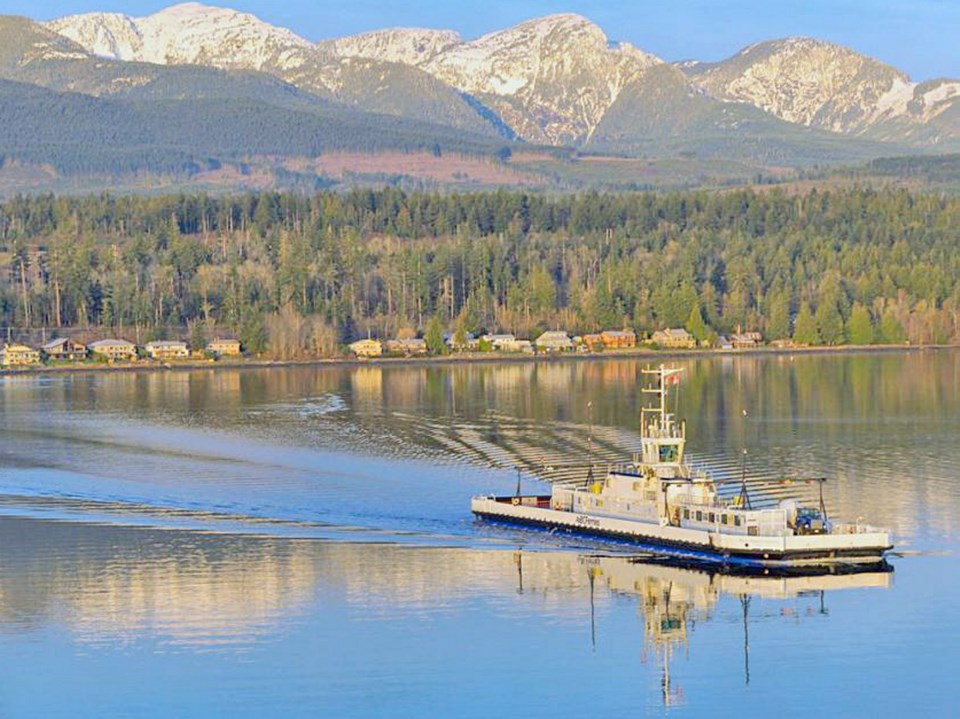B.C. Ferries is using an underwater robot on its Denman Island route this week to determine how much plastic its new cable ferry has littered into the ocean.
Area residents say they have collected more than two wheelbarrows’ worth of plastic strips from the MV Baynes Sound Connector that have washed up on beaches. The plastic coating wraps around three underwater cables that guide the ferry from Buckley Bay to Denman. Why it is peeling away remains a mystery to ferry engineers.
“We are going to fly the [remote vehicle] along the whole route of the ship to see if anything is down there,” said B.C. Ferries CEO Mark Collins. “And we’re surveying the shorelines. If there’s anything down there, we’re going to collect it and pick it up.”
B.C. Ferries plans to follow up with a cleanup effort this month that will include Collins and other senior ferry officials walking beaches and picking up plastic alongside residents.
B.C. Ferries has also hired an outside consultant to investigate the problem and has had divers check underwater reefs to ensure they are plastic-free. “We are not going to keep shedding plastic, absolutely that is my commitment to the communities,” Collins said. “We are going to fix this. And it’s not going to be a cost question.”
The ferry corporation had billed the $15-million Denman Island cable ferry as an environmental improvement when it launched in 2016. The ferry uses less fuel than its diesel-engine-powered predecessor because it relies on cable motors to pull the ship across the 1,900-metre ocean route. It is one of the longest routes for a cable ferry in the world.
“So far, it hasn’t panned out to be the wunderkind that B.C. Ferries thought it would be,” said Michael Rapati, a Denman artist and concerned resident who has picked up plastic on the beaches.
“The plastic in the cable is sloughing off anywhere from three-foot sections to microscopic sizes and we’re finding it all over Hornby Island, Denman Island, and the other islands. … Wherever the seaweed washes up, you’ll find it.”
B.C. Ferries noticed about a year ago that the plastic coating on two of the three cables was peeling off, Collins said. Two cables (the drive cable and south cable) have lost about 10 per cent of their yellow plastic, he said. A third (the north cable), with blue plastic, was not peeling at all, leaving engineers perplexed as to why it was different.
But then the third cable was hit by an unattended prawn trap in July, which gouged the coating. Since then, 15 per cent of that cable’s plastic has come off, Collins said. “We’ve been working with the manufacturer to find out what’s going on,” he said. “Even after a year of investigation, we don’t have a firm cause.”
B.C. Ferries agrees with local residents that plastic in the water is unacceptable, Collins said.
“It’s not good for the environment, it’s very distressing to the residents and it’s distressing to us, but it’s not happening with such frequency you can walk up to it and watch it happen and say, oh there’s the cause,” he said.
“So we’re doing some investigating, we’ve got the experts involved, the cable manufacturer is involved, we’ve got outside consultants involved. We’re taking every steps we can to get to the source of the problem.”
B.C. Ferries has since learned two other cable ferries in Canada that use the same coated cables have had similar plastic problems, Collins said.
The plastic coating is supposed to help the cables run more smoothly through the ferry mechanisms, reducing vibration, noise and corrosion.
But it is possible to run the ferry using only bare cables. “That’s definitely a possibility we’re looking at going forward,” Collins said.
B.C. Ferries wants to wait for an independent analysis of the situation, expected in September, before deciding whether to ditch the plastic, he said. “It’d be very nice to know the cause, because I don’t want to stumble into another problem.”
Problems with the cable ferry hit a larger sore spot for Denman residents, said Daniel Arbour, electoral area director for the Comox Valley Regional District. People have been concerned for years about plastic pollution in Baynes Sound from the fisheries sector, aquaculture and microplastics in local sewage, he said. The ferry plastic pollution only makes things worse.
“This latest one was the cherry on the top because we are finding strands of yellow plastic not only on Baynes Sound, but also on the beaches of Hornby as well,” he said. “So it’s making people pretty upset.”
It’s also frustrating for residents who think the cable ferry — with room for 150 passengers and 50 vehicles — was built too small for peak-season summer tourist traffic, Arbour said. Combined with the cable-coating difficulties, some locals are hoping that B.C. Ferries’ plan to eventually build electric-powered ships will mean the cable ferry is replaced on the Denman route.



